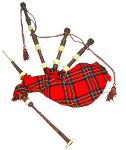

Dunstaffnage Castle
Dunstaffnage Castle wurde um das Jahr 1220 von Duncan Dubhgall, Sohn des Earls Somerled, auf einer großen Felsplatte mit Blick auf den Firth of Lorne in der schottischen Grafschaft Argyll, als mächtige Festung für den MacDougall-Clan errichtet. 1309 wurde Dunstaffnage von Robert the Bruce eingenommen und blieb etliche Jahre in königlichem Besitz.
Flora MacDonald wurde 1746 nach einem Besuch ihres Bruders in South Uist in Dunstaffnage inhaftiert. Sie verhalf Bonnie Prince Charlie nach dessen Niederlage bei Culloden zur Flucht vor den englischen Truppen, wurde dabei jedoch selbst gefasst. Nach einem Jahr wurde sie nach London in den Tower verbracht, wo sie noch ein weiteres Jahr auf ihre Freilassung warten musste.
Dunstaffnage Castle ist heute eine Ruine, wird jedoch noch immer von gut erhaltenen Steinmetzarbeiten geziert. Der Anbau des Schlosses befindet sich in Privatbesitz.
******
Dunstaffnage Castle is a partially ruined castle in Argyll and Bute, western Scotland. It lies 3 miles N.N.E. of Oban, situated on a platform of conglomerate rock on a promontory at the south-west of the entrance to Loch Etive, and is surrounded on three sides by the sea.
The castle dates back to the 13th century, making it one of Scotland’s oldest stone castles, in a local group which includes Castle Sween and Castle Tioram. Guarding a strategic location, it was built by the MacDougall lords of Lorn, and has been held since the 15th century by the Clan Campbell. To this day there is a hereditary Captain of Dunstaffnage, although they no longer reside at the castle. Dunstaffnage is maintained by Historic Scotland, and is open to the public, although the 16th century gatehouse is retained as the private property of the Captain. The prefix dun in the name means “fort” in Gaelic, while the rest of the name derives from Norse stafr-nis, “headland of the staff”.

